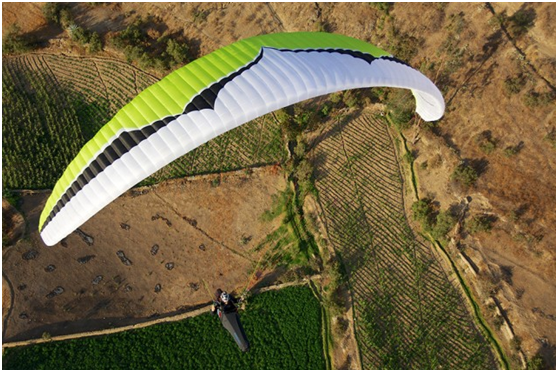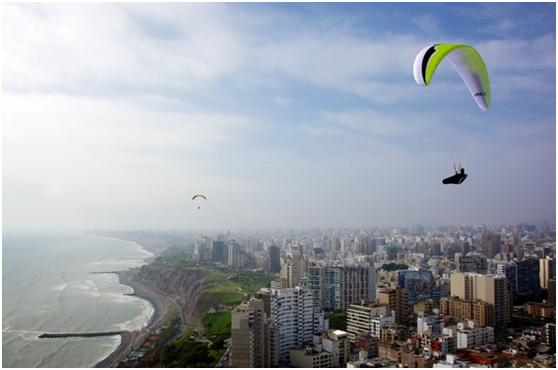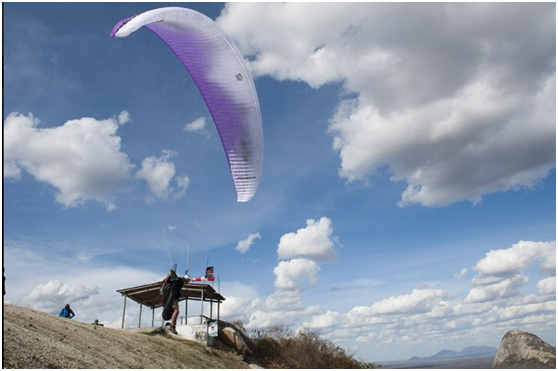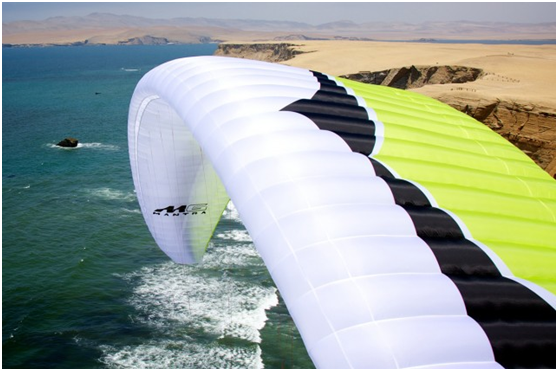ozone MANTRA M6
- ¥25000
原价:¥0
M6: THE ULTIMATE 3-LINER
The newest addition to the Mantra series is by far the most advanced3-line wing that we have ever produced. Designed for experienced XC/competitionpilots who enjoy the comfort, safety and performance of ‘classic’ EN D, the M6will have M4 pilots feeling at home straight away but with obvious andsignificant improvements.
The M6 is an evolution of the LM5, the wing which swept the top 5 spots ofthe 2013 X-Alps Race and took Chrigel to goal in record time. Over the courseof our testing and development, we have taken the 3-line concept to itsabsolute maximum, incorporating the best design elements of the LM5 whilstincreasing the number of cells, modifying the planform and optimising the lineplan. The M6 has the extra performance that was not possible with the LM5 dueto the serious weight restrictions demanded by the X-Alps.
Fully optimised for comfortable performance flying and featuring OzoneSharkNose technology, the M6 contains all of the features that have made themodern Ozone range renowned for stability and comfort. With an aspect ratio of6.92, an efficient pitch stable profile, a 23% total line drag reduction and ahighly refined internal tension the M6 offers improved performance relative tothe M4. We have measured a 0.8 glide improvement at trim speed and a full 1point at full speed!
Comfortable and intelligible feedback is provided by the M6’s 3-linesystem which allows for effective pitch control through the C risers. Thistight, compact and controllable sail behaviour further improves glideperformance in turbulent conditions, the wing steps up through wind shearconverting energy into height like a competition wing. Through the brakes thewing is extremely precise and responsive to inputs producing an incrediblycompact feel which makes it easy to turn tightly and efficiently, even in thesmallest most turbulent cores. This coordinated feel, combined with the highaspect ratio translates to superb climbing characteristics and high levels ofefficiency.
The M6 is suitable for experienced and competent XC pilots who spend morethan 100 hours per year in thermal conditions. We are confident that thecomfort and solidity of this wing will make it a favorite amongst existing M4pilots and other experienced Performance-XC class pilots, as well asSport-class pilots who are looking to move up to a wing which forms anexcellent transition to the competition class. It is however a high performanceparaglider that needs to be flown with the full attention and respect that anysuch wing deserves. An M6 pilot must have a solid understanding of bestpractices for recovery from incidents in flight.
S | MS | ML | L* | |
Number of cells | 66 | 66 | 66 | 66 |
Projected Area (m2) | 18.6 | 19.6 | 20.8 | 22 |
Flat area (m2) | 22 | 23.3 | 24.6 | 26 |
Projected span (m) | 9.7 | 9.97 | 10.25 | 10.55 |
Flat span (m) | 12.35 | 12.69 | 13.04 | 13.43 |
Projected Aspect Ratio | 5 | 5 | 5 | 5 |
Flat aspect ratio | 6.9 | 6.9 | 6.9 | 6.9 |
Root Chord (m) | 2.25 | 2.32 | 2.38 | 2.45 |
Glider Weight (kg) | 5.1 | 5.35 | 5.55 | 5.85 |
In-flight weight range (kg) | 65-85 | 80-95 | 90-105 | 100-120 |
EEN / LTF | D | D | D | D |
* - The M6 L wasoriginally intended to have a maximum weight of 115kg - in line with the rangesof the other sizes - but experience has shown that the L, like the other sizes,is best flown near or at the maximum weight. Optimum loading for the L is>110kg, and the upper weight has been increased to accommodate pilots up to120kg, so that they can fly the wing in a certified configuration. Sink rate,glide performance, and the certification flight tests are all unaffected atthis maximum weight.
· Top Surface Cloth: Dominico 30DMF
· Bottom Surface Cloth: Dominico30D MF
· Rib cloth: Porcher 7000E29 /Dominico 30DFM
· Upper lines: Edelrid 8000U
· Lower Lines: Edelrid 8000U








THE CONCEPT:
It’s the “ultimate” 3 Liner.
We questioned whether or not the replacement of the M4 should be a 2 lineror a 3 liner. Developing the LM5 for the X-Alps helped us making the decision.The 3 liner option was more appealing in many ways.
We are confident that the M6 is going to be a classic: It is our best ever3 liner for keen XC and competition pilots.
NEW FEATURES:
· A completely new structure; based on thearchitecture of the Delta2, but adjusted to work on a sail with a higher AR.
· The higher flat AR of 6.9 gives betterclimb performance. We used a high arc to help the sail’s tension in order togive the wing more cohesion and very importantly to keep good roll authority inthe turn. The result is precise handling, without the feeling of flying a wingwith more AR than the M4.
· The M6 features SharkNose technology. Theforgiving nature of the profile at low and high angles of attack sharpens thehandling and gives a high level of spin resistance. This allows the pilot tomake deep brake inputs when necessary to adjust the turn and bank angle asrequired.
· At low angles of attack the SharkNoseprofile gives more solidity or collapse resistance than a ‘classic’ profile asused in the M4. This improves the True Performance making it more useable inturbulent conditions and due to the stability of the chord, the pilot will beable to fly more efficiently.
· Flying the M6 on the rear risers is alsomore intuitive than with the M4. The feeling on the Cs is more linear and theeffect on the wing is more progressive and effective.
· Thanks to the good stability and the goodtesting behaviour, we were able to extend the top speed by a few kph.
· Line drag optimisation: 22m total linelength and 19% saved, compared to the M4.
· Max glide improved by 0.7-0.8pt and the glideat the max speed of the M4 has been improved by at least 1pt!
· Advanced 3D shaping, to improve theairflow on the LE, and MiniRibs to reduce the drag at the TE.
· YOUR M6 AND SIV
· The M6 was certified with the use ofadditional collapse lines for accelerated manoeuvres only.
· The M6 is a new generation wing whichincorporates our latest technology from the LM5 and Enzo2. Alongside theSharkNose, one of the developments we have incorporated is moving the A tabsfurther away from the leading edge and deeper into the chord. This makes thewing more collapse resistant; more solid, stable and confidence inspiring.
· It is possible to perform SIV trainingwith the M6, in fact we strongly recommend it. Trim speed symmetric andasymmetric collapses using the A risers to deflate the wing as normal arepossible. However, we strongly recommend to not perform full speed symmetricand asymmetric collapses with the A risers alone. All other manoeuvres however,are possible.
· Pulling the A risers or collapse lines isan artificial way of simulating real life collapses. In real-life collapses theM6 behaves in a similar manner as any other wing in the same category, however,to induce a full speed collapse that conforms to the EN certificationrequirements it must be done with the use of additional collapse lines. Whenyou induce a full speed side collapse without using collapse lines the resultsmay be different than during certification because the canopy pre-accelerates*,further increasing the artificiality of the test. Using collapse lines reducesthe amount of pre- acceleration, this makes the collapse more in line withcertification requirements. Collapse lines need to be mounted accurately, withattachment tabs sewn into the nose of the wing, but since they are not suppliedwith the wing we strongly recommend to not induce full speedsymmetric/asymmetric collapses at all.
· *Pre-acceleration is when the glideraccelerates before collapsing. Imagine flying at full speed and pulling an Ariser to induce an asymmetric collapse (remember using the A riser is alreadyan artificial way of simulating real life collapses). With the A’s further backin the chord, instead of deforming and folding immediately, the side that youpull actually accelerates first (because of the reduction of AofA), thusmomentarily causing a turn in the opposite direction. Therefore, at the pointof collapse because everything is not in line - slight turn, slight roll/yawingaction in the other direction - collapses are even more artificial, with potentiallya greater kink angle, more chance of shock re-inflations and possibly moredynamic reactions. Such collapses are outside of the requirements of ENcertification and do not represent the majority of real life collapses.